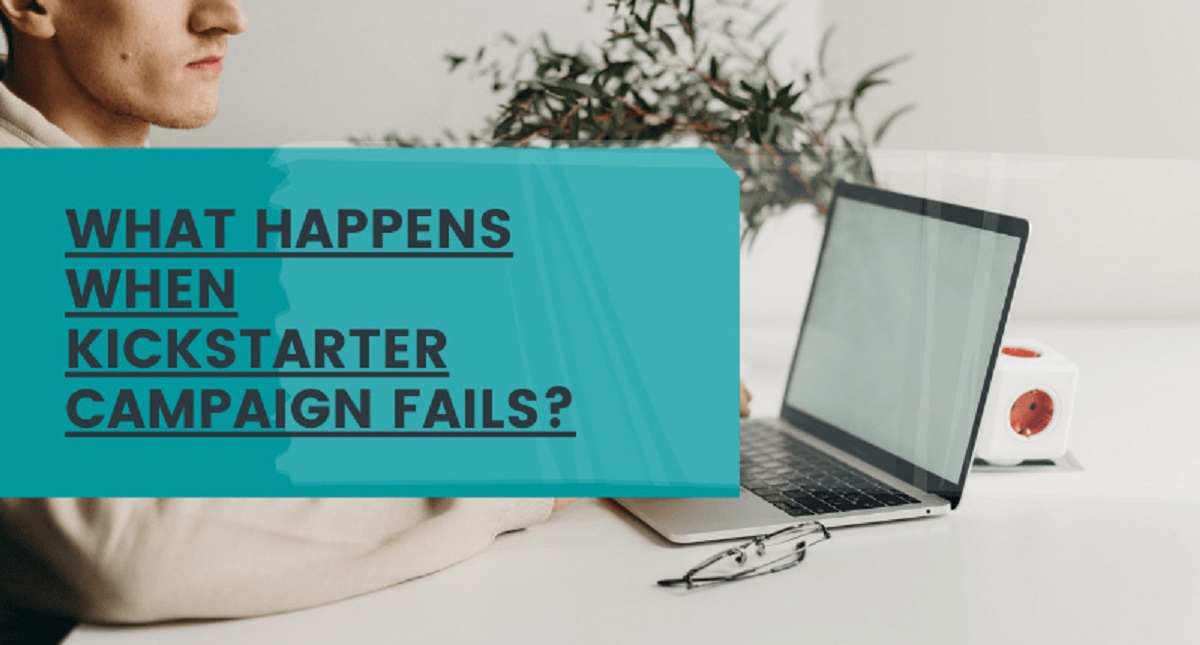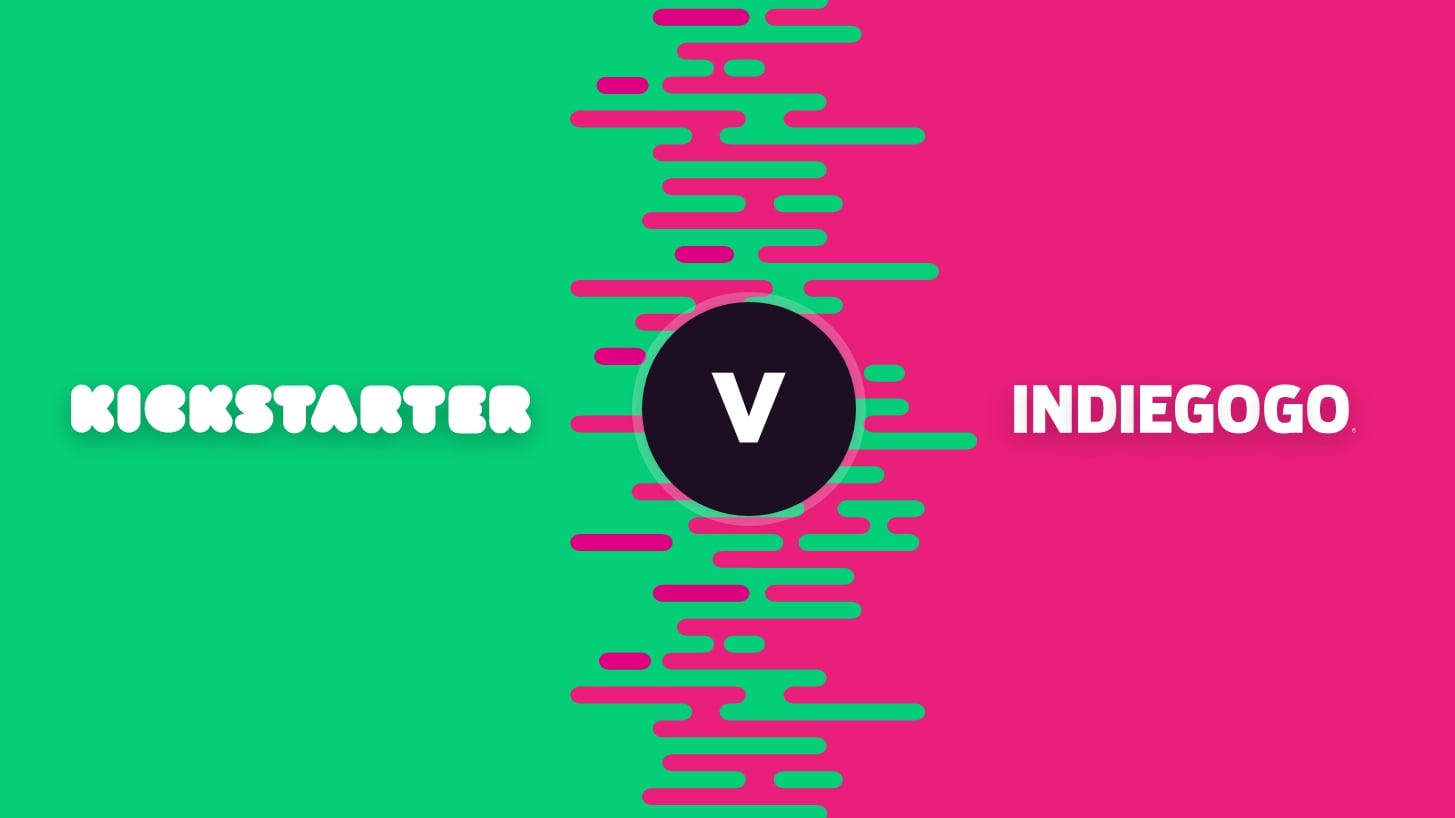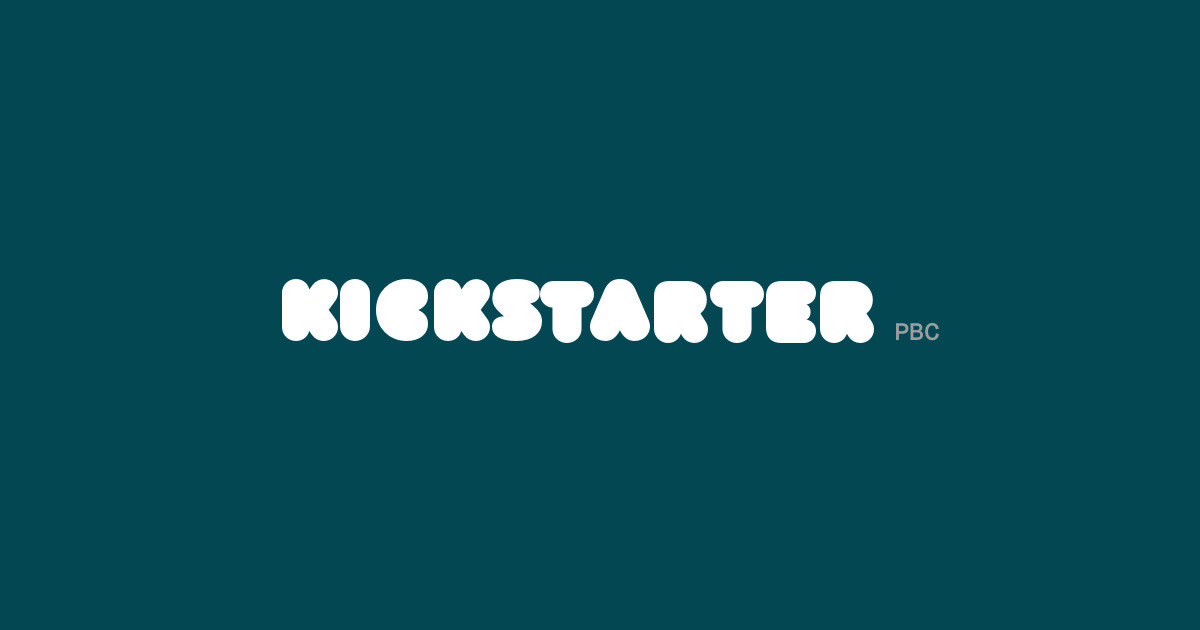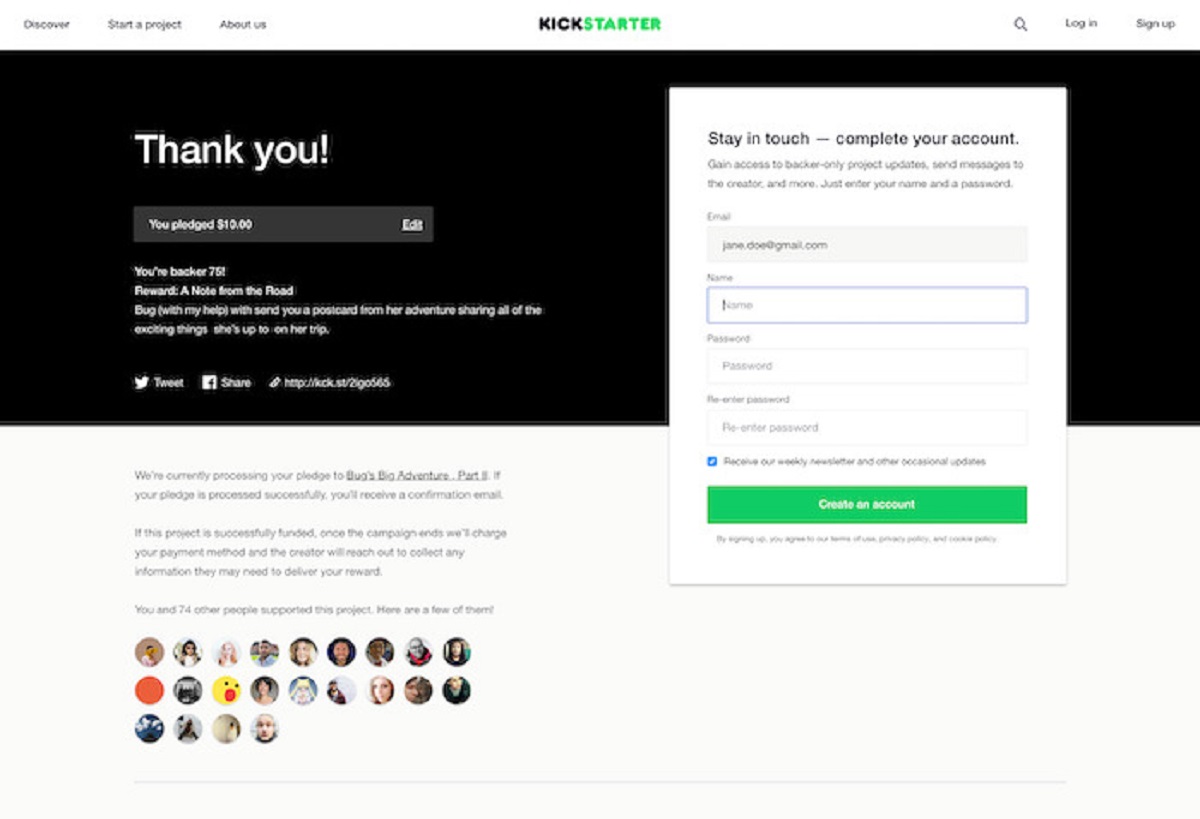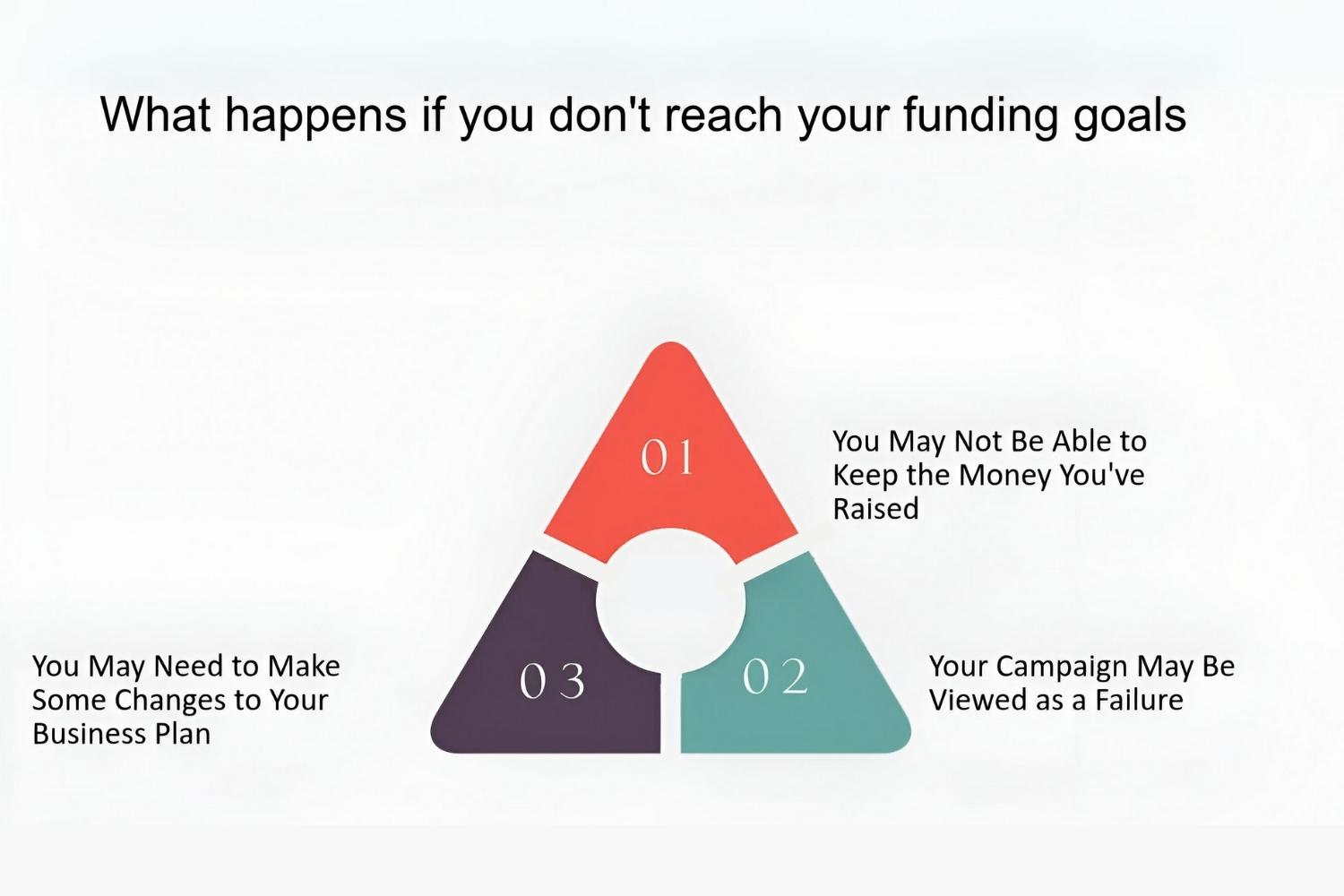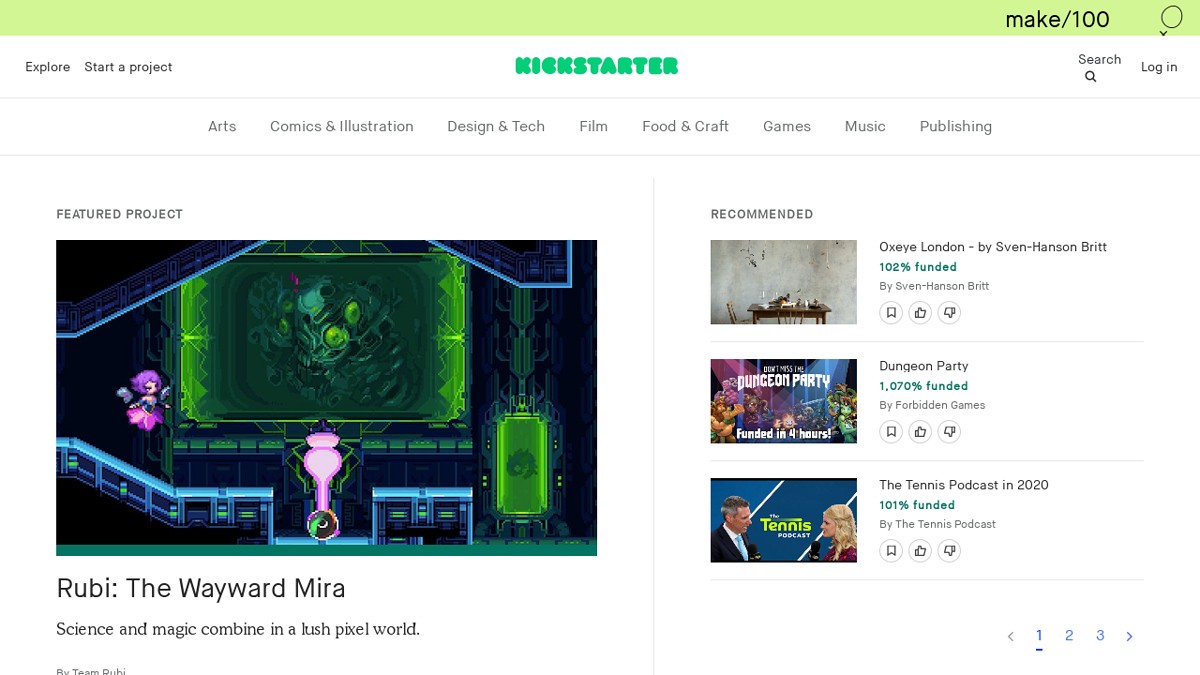Introduction
Kickstarter has revolutionized the way entrepreneurs, artists, and creators bring their ideas to life. It is a crowdfunding platform that allows innovators to connect with potential backers and receive financial support for their projects. However, not all Kickstarter projects meet their funding goals and successfully come to fruition. In fact, many projects on Kickstarter fail to reach their desired outcome and leave both creators and backers disappointed. Understanding the reasons behind these failures can provide valuable insights for future Kickstarter endeavors.
Creating a successful Kickstarter project requires careful planning, realistic goal-setting, effective communication, and a solid budget. In this article, we will explore the common pitfalls that can lead to project failure on Kickstarter. We will delve into the various factors that contribute to unsuccessful campaigns and discuss the consequences that creators and backers must face when a project doesn’t meet its objectives. Furthermore, we will outline steps that creators can take to mitigate the impact of a failed project and learn from the experience.
It is important to note that failure is not the end of the road. Many successful creators have faced setbacks and failures before eventually achieving their goals. By understanding the reasons why Kickstarter projects fail, creators can adapt their strategies and increase their chances of success. Additionally, backers can gain insights into the risks associated with supporting crowdfunding projects and make more informed decisions about where to invest their funds.
Whether you are a creator looking to launch a Kickstarter campaign or a supporter considering backing a project, this article will shed light on the potential challenges and provide guidance for navigating the unpredictable world of crowdfunding. Let’s explore the reasons why Kickstarter projects fail and what happens when a project doesn’t go as planned.
Reasons why Kickstarter projects fail
While Kickstarter has provided a platform for countless creative ideas to come to life, there are several reasons why projects fail to achieve their funding goals. Understanding these factors is crucial for navigating the crowdfunding landscape effectively. Here are some of the most common reasons why Kickstarter projects fall short:
- Lack of planning and preparation: Many project creators underestimate the amount of planning and preparation needed to run a successful Kickstarter campaign. Without a well-thought-out strategy, projects can struggle to gain traction and fail to capture the interest of potential backers.
- Unrealistic goals and timelines: Setting unrealistic goals or timelines can be a recipe for disaster. Creators who aim too high or promise to deliver their projects within an unrealistic timeframe may lose credibility and fail to reach their funding targets.
- Poor communication and updates: Communication is key in any crowdfunding campaign. Failure to provide regular updates, respond to backer inquiries, or address concerns can lead to a loss of trust and ultimately result in project failure.
- Insufficient funds and budgeting: Inadequate financial planning is a common pitfall for Kickstarter projects. Creators must carefully estimate expenses, including production costs, marketing, and shipping, to ensure they secure enough funding to bring their project to fruition.
- Competitive market and lack of differentiation: With thousands of projects vying for attention on Kickstarter, standing out from the crowd is essential. Creators who fail to offer a unique selling point or adequately differentiate themselves may struggle to attract backers.
- Legal and copyright issues: Violating copyright laws or facing legal disputes can quickly derail a Kickstarter project. Creators must ensure they have the necessary licenses and permissions to avoid legal complications that can lead to project failure.
These are just a few of the most common reasons why Kickstarter projects fail. Each project is unique, and success depends on a multitude of factors. However, by understanding these common pitfalls, creators can better navigate the challenging landscape of crowdfunding and increase their chances of achieving their project’s funding goals and ultimately delivering on their promises to backers.
Lack of planning and preparation
One of the key reasons why Kickstarter projects fail is a lack of proper planning and preparation. Running a successful crowdfunding campaign requires careful consideration and strategic thinking. Here are some key aspects that creators often overlook when it comes to planning and preparation:
Setting clear goals: Before launching a Kickstarter project, creators need to clearly define their goals. This includes determining the funding target, the timeline for the project, and the specific deliverables they plan to offer backers. Without well-defined goals, there is a lack of focus and direction, which can make it difficult to gain traction and attract potential backers.
Knowing your target audience: Understanding the target audience is crucial for a successful Kickstarter campaign. Creators need to research and identify their target demographic, including their interests, preferences, and online behaviors. This knowledge can help tailor the campaign’s messaging, rewards, and marketing activities to resonate with potential backers.
Building a strong network: A strong network of supporters can greatly contribute to the success of a Kickstarter project. Creators should invest time and effort in building a community of fans, influencers, and potential backers before launching the campaign. Engaging with this network, whether through social media, email newsletters, or personal connections, can help generate initial buzz and early support for the project.
Creating compelling visuals and content: In the digital age, visual elements and engaging content play a crucial role in capturing attention and conveying the project’s value proposition. Creators should invest in high-quality visuals, such as videos, images, and graphics, that effectively showcase their project and its potential impact. Additionally, well-crafted and persuasive written content is essential in communicating the project’s goals, motivations, and benefits to potential backers.
Developing a robust marketing strategy: Simply launching a Kickstarter project is not enough; creators need to actively promote it to reach a wider audience. Having a comprehensive marketing strategy that includes social media campaigns, targeted advertising, influencer partnerships, and outreach to relevant media outlets can significantly boost the visibility and reach of the project.
By neglecting these crucial aspects of planning and preparation, creators risk launching their projects without a solid foundation. This lack of foresight can lead to a lack of interest, limited traction, and ultimately, project failure. Therefore, it is vital for creators to invest time and effort in thorough planning and preparation to maximize their chances of success on Kickstarter.
Unrealistic goals and timelines
One of the most common reasons why Kickstarter projects fail is setting unrealistic goals and timelines. While it’s natural to be ambitious and eager to bring a project to life, it is crucial to strike a balance between feasibility and aspiration. Here are some key considerations to avoid setting unrealistic expectations on Kickstarter:
Financial goals: Setting a funding target that is too high can significantly impact the success of a Kickstarter campaign. It is important to conduct thorough research and assess the market demand for the project to determine a realistic funding goal. An excessively high target may deter potential backers, as they may perceive it as unattainable or not worth their investment.
Timeline: It is common for creators to underestimate the time required to complete a project. Overpromising and setting an unrealistic timeframe can lead to delays and disappointment among backers. Creators must carefully evaluate the complexity of their project, accounting for possible setbacks, manufacturing and production time, and unforeseen challenges. A well-planned and realistic timeline builds trust with backers and demonstrates a commitment to delivering on time.
Scope: Defining the scope of the project accurately is crucial to avoid overwhelming yourself and your team. Many Kickstarter projects fail because they try to tackle too much at once. Keeping the project’s scope manageable allows for better resource allocation, quality control, and on-time delivery. Creators should identify the core features or deliverables that will have the most impact and focus on executing them successfully.
Achievable milestones: Breaking down the project into smaller milestones helps to track progress and manage expectations. It is important to set achievable milestone goals that can be met within the allocated timeline. This not only provides a sense of accomplishment but also instills confidence in backers that the project is on track.
Flexibility: Unexpected challenges and delays are common in any creative endeavor. Creators should be prepared to adapt and adjust their goals and timelines as needed. Maintaining open communication with backers about any changes or setbacks ensures transparency and helps manage expectations.
Setting realistic goals and timelines is essential for fostering trust and credibility with backers. It demonstrates that creators have carefully considered the project’s feasibility and are committed to delivering on their promises. By avoiding the pitfalls of unrealistic expectations, creators can increase their chances of success on Kickstarter and build a positive reputation in the crowdfunding community.
Poor communication and updates
Effective communication is the cornerstone of a successful Kickstarter campaign. Poor communication and a lack of updates can significantly impact the perception of a project and ultimately lead to its failure. Here are some key points to consider regarding communication and updates on Kickstarter:
Regular and timely updates: Backers invest their money and trust in a project, and they expect to be kept informed about its progress. Regular and timely updates are essential to demonstrate transparency and maintain engagement with backers. Creators should provide updates on milestones achieved, challenges faced, and any changes or developments in the project. This keeps backers informed and reassures them that their support is valued.
Responding to backer inquiries: Backers may have questions, concerns, or suggestions regarding the project. It is crucial for creators to actively engage with their community and respond promptly to backer inquiries. This demonstrates a commitment to addressing concerns and building a supportive relationship with backers.
Honest and transparent communication: Honesty is key in maintaining trust and credibility with backers. If there are unexpected challenges, delays, or changes in the project’s direction, it is important to communicate openly and honestly. Backers appreciate transparency and are more likely to continue supporting a project when they feel informed and involved.
Setting realistic expectations: Communication is not just about providing updates; it’s also about managing expectations. Creators should be clear about the limitations and potential risks associated with the project. Providing realistic expectations helps backers understand the challenges involved and prevents disappointment or frustration if unforeseen circumstances arise.
Utilizing multiple communication channels: Kickstarter offers various communication channels, including project updates, comments sections, and direct messages. Creators should leverage these platforms to communicate with backers effectively. Additionally, utilizing external communication channels such as social media and email newsletters can further enhance engagement and reach a wider audience.
Post-campaign communication: Communication shouldn’t stop once the campaign ends. Creators should continue to update backers on the status of the project beyond the funding phase. Regularly communicating the progress, challenges, and estimated delivery timelines helps maintain trust and keeps backers excited and engaged even after the funding goal is reached.
By prioritizing effective communication and timely updates, creators can foster a strong relationship with their backers. Engaging in open and honest conversations and addressing concerns promptly builds trust and confidence, increasing the likelihood of a successful Kickstarter campaign. Good communication practices also contribute to maintaining a positive reputation and potentially attracting future backers for subsequent projects.
Insufficient funds and budgeting
A crucial factor that contributes to the failure of many Kickstarter projects is insufficient funds and inadequate budgeting. Running a successful campaign requires careful financial planning and understanding the true costs involved. Here are some key points to consider when it comes to funds and budgeting on Kickstarter:
Accurate estimation of expenses: Creators must conduct a thorough analysis of the costs associated with their project. This includes not only production or development expenses but also marketing, packaging, shipping, and any other relevant costs. Underestimating expenses can lead to funding shortfalls and may result in an inability to fulfill backer rewards.
Setting a realistic funding target: A well-planned budget should guide creators in setting a realistic funding goal. It is crucial to consider all expenses, including contingency funds for unexpected costs or setbacks. Setting a funding target that covers these expenses helps ensure that the project can be successfully completed without running out of funds.
Accounting for platform fees and taxes: Kickstarter charges platform fees for successful projects. Creators need to account for these fees when setting their funding target and budget. Additionally, it’s essential to consider any applicable taxes or duties that may be incurred during production, shipping, or selling of the project. Failure to factor in these costs can significantly impact the project’s financial viability.
Cost-effective production and sourcing: Finding ways to reduce production costs without compromising quality is crucial for maintaining a healthy budget. Creators should explore options for cost-effective production processes, sourcing materials at competitive prices, and utilizing resources efficiently. By optimizing production expenses, creators can maximize the value they deliver to backers while staying within budget.
Contingency planning: Unforeseen circumstances can arise during the course of a Kickstarter project. Creators should allocate a portion of their budget as a contingency fund to mitigate any unexpected costs or challenges that may arise. A contingency fund provides a safety net and helps avoid financial strain if additional expenses occur.
Monitoring and tracking expenses: Throughout the project timeline, it is important to monitor and track expenses carefully. Regularly reviewing the budget and comparing it to actual spending helps identify any variances and allows for adjustments as needed. Keeping a close eye on expenses can prevent budget overruns and ensure financial stability throughout the project.
By effectively managing funds and budgeting, creators can increase the likelihood of a successful Kickstarter campaign. Adequate planning, accurate cost estimation, and cautious budgeting ensure that creators have the necessary funds to deliver on their promises. It also helps build trust with backers, as they can see that their contributions are being utilized responsibly. Proper financial management is essential for the long-term sustainability of a project and can pave the way for future crowdfunding endeavors.
Competitive market and lack of differentiation
As Kickstarter continues to gain popularity, the market has become increasingly competitive. With thousands of projects vying for attention, it is crucial for creators to differentiate themselves and stand out from the crowd. Failure to do so can lead to a lack of interest and ultimately result in project failure. Here are some key points to consider regarding the competitive market and lack of differentiation on Kickstarter:
Researching the market: Before launching a Kickstarter campaign, creators should conduct thorough market research. This involves analyzing similar projects, identifying competitors, and understanding the current trends and demand within the target niche. By gaining insights into the market landscape, creators can find gaps and opportunities for differentiation.
Unique value proposition: To succeed in a competitive market, creators must clearly articulate the unique value proposition of their project. What sets it apart from similar offerings? How does it solve a problem or fulfill a need? Communicating these differentiating factors effectively helps captivate potential backers and convinces them to invest in the project.
Distinctive branding and storytelling: Creating a strong brand identity and crafting a compelling narrative can make a project stand out. A cohesive visual presence, engaging storytelling, and a well-defined brand personality can generate interest and connect with potential backers on a deeper level. Creators should invest in professional branding and storytelling to make a memorable impression.
Innovative features or ideas: Introducing innovative features, ideas, or approaches can give a project a competitive edge. Creators should strive to offer something unique, whether it’s a technological advancement, a fresh perspective, or a creative twist. By pushing the boundaries of their industry or niche, creators can capture the attention and support of backers.
Building a community: A loyal and engaged community of supporters can significantly contribute to the success of a Kickstarter project. Creators should focus on building relationships and actively engaging with their target audience. Encouraging feedback, involving backers in the project’s development process, and fostering a sense of community can differentiate a project and build a passionate following.
Effective marketing and promotion: Even the most innovative project can struggle to gain traction without effective marketing and promotion. Creators should develop a comprehensive marketing strategy that utilizes various channels, such as social media, influencers, and relevant publications, to generate awareness and interest. Tailoring the messaging to highlight the unique aspects of the project helps it stand out in the crowded marketplace.
By addressing the competitive nature of the market and finding ways to differentiate themselves, creators can increase their chances of success on Kickstarter. Offering a unique value proposition, crafting a compelling brand and narrative, and actively engaging with the target audience are vital steps in standing out from the competition. By being innovative, building a community, and implementing effective marketing strategies, creators can capture the attention and support of backers, ultimately leading to a successful Kickstarter campaign.
Legal and copyright issues
When launching a Kickstarter project, creators must navigate potential legal and copyright issues to ensure the project’s success. Ignoring or mishandling these matters can lead to significant setbacks or even project failure. Here are some key considerations to avoid legal and copyright issues on Kickstarter:
Intellectual property rights: Before launching a project, creators should ensure they have the necessary intellectual property rights for their product or idea. This includes trademarks, copyrights, or patents. Failing to secure these rights can result in legal disputes and potential infringement claims, which can be costly and time-consuming to resolve.
Exclusive rights: Creators must respect the exclusive rights of others. This requires conducting thorough research to ensure that the project or its components do not infringe upon any existing patents, trademarks, or copyrights of others. Infringing on the intellectual property rights of others can lead to legal action that can quickly derail a Kickstarter project.
Licensing and permissions: If a project involves the use of copyrighted material, such as music, artwork, or literary works, creators must obtain the necessary licenses or permissions. This includes seeking consent from the original creator or securing appropriate licenses from copyright holders. Failing to obtain the required permissions can lead to legal consequences and potentially result in the project being blocked or removed from the platform.
Privacy and data protection: Creators must also be mindful of privacy and data protection regulations when collecting and handling personal information from backers or customers. This includes obtaining proper consent, securely storing data, and following applicable privacy laws. Inadequate protection of personal information can result in reputational damage and legal repercussions.
Terms of service and liability: Clear terms of service and liability disclaimers are essential to protect creators from potential legal liabilities. These documents outline the rights and responsibilities of both the creator and the backer, setting expectations and mitigating risk. Consulting legal professionals to draft comprehensive terms of service and liability disclaimers can ensure legal compliance and protect the creator’s interests.
International legal considerations: Kickstarter projects can reach a global audience, which introduces additional legal complexities. Creators must understand and comply with international laws and regulations, including customs, import/export restrictions, and consumer protection laws in various countries. Failure to adhere to international legal requirements can lead to shipping delays, additional costs, or even legal consequences.
By proactively addressing potential legal and copyright issues, creators can minimize risks and ensure a smoother experience for both themselves and their backers. Seeking legal advice, securing necessary intellectual property rights, obtaining licenses and permissions, and adhering to privacy regulations are essential steps to protect the project and its stakeholders. Taking the time to understand and comply with legal requirements demonstrates professionalism, builds trust with backers, and increases the chances of a successful Kickstarter campaign.
Examples of failed Kickstarter projects
While Kickstarter has seen many success stories, there have been numerous projects that have failed to meet their funding goals or deliver on their promises. These examples showcase the challenges and pitfalls that creators can encounter on Kickstarter. Here are a few notable examples of failed Kickstarter projects:
The Zano mini-drone: The Zano mini-drone project raised more than £2 million on Kickstarter, promising a portable and autonomous drone with advanced features. However, despite the initial hype and support, the creators faced multiple technical and manufacturing issues, resulting in delays and ultimately failing to deliver the product to backers.
The Triton underwater breathing device: The creators of the Triton claimed their device used artificial gills to extract oxygen from water, offering a revolutionary solution for underwater breathing. The project gained significant media attention and raised over $800,000 on Kickstarter. However, experts later debunked the technology, and the project was ultimately canceled, leaving backers without the promised product.
Coolest Cooler: The Coolest Cooler project aimed to create a feature-packed cooler with built-in speakers, a blender, and other unique functionalities. It became one of the most successful Kickstarter campaigns, raising over $13 million in funding. However, manufacturing and production challenges, coupled with mismanagement of funds, led to significant delays and frustration among backers. Many were left waiting for years before receiving their coolers, leading to a wave of criticism and controversy.
These examples serve as reminders of the risks associated with Kickstarter projects. They highlight the importance of realistic planning, effective project management, and the need for creators to navigate unforeseen challenges effectively. It is essential for creators to learn from these failures and take steps to avoid similar pitfalls in their own Kickstarter endeavors.
It is worth noting that these examples represent a small fraction of the many successful projects on Kickstarter. There are countless creators who have delivered on their promises, fulfilled backer rewards, and created innovative products with the support of the crowdfunding community.
By studying failed Kickstarter projects, both creators and backers can gain valuable insights to mitigate risks, set realistic expectations, and make informed decisions when participating in crowdfunding campaigns. Understanding the challenges and learning from the failures of others allows creators to build stronger campaigns and helps backers make more informed choices about which projects to support.
Consequences of project failure
When a Kickstarter project fails to reach its funding goal or doesn’t deliver on its promises, there are significant consequences for both creators and backers. These consequences go beyond financial aspects and can have a lasting impact on various aspects of the project and those involved. Here are some key consequences of project failure on Kickstarter:
Loss of time and effort: For creators, a failed Kickstarter project means an immense loss of time and effort invested in planning, development, and promotion. The energy spent on the campaign could have been channeled elsewhere, potentially hindering progress on future projects.
Financial repercussions: Failed projects can result in financial strain for creators. They may have invested personal funds into the project or face the challenge of repaying backers who expected a finished product. Creators may also have to deal with legal fees, manufacturing costs, or penalties associated with project cancellation.
Damage to reputation and credibility: Failing to deliver on promises can damage the reputation and credibility of the creator. Backers who feel deceived or disappointed may share negative feedback and reviews, impacting the creator’s ability to gain support for future projects. This loss of trust can be challenging to overcome and may deter potential backers from supporting future campaigns.
Impact on backers and supporters: Backers of failed Kickstarter projects may feel frustrated, betrayed, or disillusioned. They may have eagerly anticipated the project and invested their money based on the creator’s promises. Project failure can lead to a loss of confidence in the crowdfunding platform and reluctance to support future campaigns. The negative experience may discourage backers from engaging in similar ventures or trusting other creators on Kickstarter.
It’s important to note that while project failure can have significant consequences, it doesn’t mean the end of the road. Creators have the opportunity to learn from their mistakes, regroup, and potentially relaunch their projects with improvements. By openly communicating with backers and addressing the reasons for the failure, creators can work toward restoring trust and rebuilding their reputation.
For backers, while disappointment is inevitable in the face of project failure, it is essential to remember that crowdfunding inherently carries risks. Participating in campaigns involves taking a leap of faith and understanding that not all projects succeed.
The consequences of project failure on Kickstarter serve as reminders of the challenges creators face and the risks backers assume. Through transparency, open communication, and a commitment to continuous improvement, creators can strive to minimize the impact of failure and work toward future success. Backers play a crucial role in providing constructive feedback and supporting creators who demonstrate resilience and a willingness to learn from their experiences.
Loss of time and effort
One of the significant consequences of a failed Kickstarter project is the loss of time and effort for creators. Running a crowdfunding campaign requires extensive planning, preparation, and execution, all of which demand significant investments of time and energy. When a project fails to meet its funding goal or falls short of expectations, it can feel like a tremendous setback. Here are some key points to consider regarding the loss of time and effort in a failed Kickstarter project:
Planning and development: From conceptualization to fine-tuning the project details, creators spend countless hours planning and developing their ideas for the Kickstarter campaign. This includes defining project goals, designing prototypes, creating compelling visuals, and developing marketing strategies. The time and effort invested in these early stages can feel wasted if the project fails to reach its funding target.
Promotion and marketing: Promoting a Kickstarter campaign requires significant effort to reach potential backers. Creators invest time and resources in social media marketing, content creation, email campaigns, and engaging with influencers or the press. Crafting compelling messages and effectively conveying the project’s value proposition takes time and creativity. If the campaign fails, all the effort put into promotion can feel disheartening.
Engaging with backers: Throughout the campaign, creators interact with backers, answering questions, providing updates, and building a sense of community. This engagement helps foster trust and strengthens the creator-backer relationship. However, if the project ultimately fails, it can be disheartening to realize that all the time and effort invested in building these connections may not yield the desired outcome.
Administrative tasks: Managing a Kickstarter campaign involves various administrative tasks, such as tracking pledges, coordinating logistics, and managing financial transactions. These tasks require attention to detail, organization, and the ability to juggle multiple responsibilities. When a project fails, creators may feel that the administrative efforts put into the campaign were in vain.
It is important to recognize that while a failed Kickstarter project can be disheartening, it is not necessarily a complete loss. The experience gained from the process, despite the outcome, can be valuable. Creators can learn from their mistakes, refine their strategies, and apply the lessons learned to future endeavors. The time and effort invested in a failed project can serve as a stepping stone for future success.
Moreover, backers can also play a role in supporting creators who have experienced failure. Providing constructive feedback, encouragement, or even supporting future projects can help creators regain their motivation and propel them towards future achievements.
While the loss of time and effort in a failed Kickstarter project can be discouraging, it is important for creators to remember that setbacks and failures are part of the entrepreneurial journey. By embracing the lessons learned and persisting in their pursuit of innovation and creativity, creators can turn a setback into a valuable learning experience and ultimately achieve their goals.
Financial repercussions
When a Kickstarter project fails to meet its funding goal or encounters other challenges that prevent the successful delivery of the promised product or rewards, there are significant financial repercussions for both creators and backers. These repercussions can have lasting effects and potentially lead to financial strain and setbacks. Here are some key points to consider regarding the financial repercussions of a failed Kickstarter project:
Personal investment: Creators often invest their personal funds into the project, covering expenses such as prototyping, production, marketing, and fulfillment. If a project fails, creators may face a significant financial loss, as these personal investments may not be recoverable. This loss can have long-term consequences, impacting their ability to pursue future projects or generating financial instability.
Backer refunds: When a Kickstarter project fails, creators are typically obligated to refund backers who pledged money towards the project. Refunding can be a complex process, as it involves returning funds to individual backers, handling transaction fees, and potentially dealing with currency conversions. Refunding a large number of backers can be financially challenging, especially if the project expenses have depleted the available funds.
Legal fees and penalties: Project failure can lead to potential legal issues and expenses. Creators may face legal challenges, such as breach of contract claims or copyright infringement allegations. These legal proceedings can result in additional financial burdens, including legal fees, settlements, or penalties.
Production costs: Creators often have to deal with the cost of producing or manufacturing the project, even if it ultimately fails. These expenses can include materials, manufacturing fees, packaging, and shipping. The financial burden of these unrecoverable costs adds to the overall impact of project failure, potentially leaving creators in a precarious financial situation.
Lost opportunity and revenue: A failed Kickstarter project means a missed opportunity for generating revenue and potential profits. The funds that could have been raised through a successful campaign might have been allocated towards further product development, expanding the business, or fulfilling other financial obligations. The financial implications of a failed project can extend beyond the immediate financial losses associated with the campaign itself.
It is essential for creators to carefully manage their finances and consider the potential risks and financial implications before launching a Kickstarter project. Adequate planning, budgeting, and risk assessment are crucial to mitigate the financial repercussions of a failed campaign. Open communication and transparency with backers about the financial challenges faced can also help maintain their trust and understanding.
For backers, while there may be financial implications if a project fails, it is important to acknowledge that crowdfunding inherently carries risks. Participating in Kickstarter campaigns involves a level of uncertainty, and backers should be aware of this before pledging their funds.
While the financial repercussions of a failed Kickstarter project can be significant, it is important for creators to learn from their experiences, reassess their strategies, and consider alternative approaches for future projects. Seeking professional advice and support, exploring alternative funding sources, or reevaluating the project’s scope can help creators navigate the financial challenges and work towards future success.
Damage to reputation and credibility
One of the significant consequences of a failed Kickstarter project is the potential damage to the reputation and credibility of the creator. When a project fails to meet its funding goals or deliver on its promises, it can significantly impact how creators are perceived by both backers and the wider community. Here are some key points to consider regarding the damage to reputation and credibility in a failed Kickstarter project:
Loss of trust: Backers place their trust in creators when they support a Kickstarter campaign. When a project fails, it can lead to a loss of trust and confidence in the creator’s ability to deliver on their promises. Backers may feel deceived, disappointed, or even betrayed, tarnishing the relationship between creators and their most dedicated supporters.
Negative reviews and word-of-mouth: A failed Kickstarter project can lead to negative reviews and word-of-mouth, as dissatisfied backers share their experiences and express their frustrations. These negative sentiments can spread quickly within the crowdfunding community and impact the perception of the creator’s reputation. Potential backers may be deterred from supporting future campaigns based on these negative reviews.
Online reputation: In the digital age, online reputation plays a significant role in how creators are perceived. Negative experiences from failed Kickstarter projects can lead to negative reviews, comments, or forum discussions that can damage a creator’s online reputation. Search engine results may highlight the failures, making it challenging for creators to overcome these negative associations in future endeavors.
Trust within the crowdfunding community: The crowdfunding community thrives on trust and the belief that backers are supporting innovative and reliable projects. When a creator fails to deliver on their promises or falls short of expectations, it can erode trust not only in that specific creator but also in the crowdfunding platform as a whole. This loss of trust can have a broader impact on the willingness of backers to support other projects, leading to a decrease in overall crowdfunding participation.
Professional opportunities: A damaged reputation and credibility can impact creators beyond the realm of crowdfunding. It may affect their ability to secure partnerships, collaborations, or funding in future endeavors. Potential investors or business partners may be hesitant to engage with creators who have a track record of failed projects, perceiving them as unreliable or lacking the necessary expertise.
Recognizing the potential damage to reputation and credibility in a failed Kickstarter project, creators must take steps to address the situation. Openly communicating with backers about the reasons for the failure, offering sincere apologies, and providing explanations can help rebuild trust and mitigate damage. Learning from the experience, taking responsibility for the mistakes made, and demonstrating a commitment to improvement can also help restore reputation and credibility over time.
Additionally, creators can focus on showcasing their growth and demonstrating their ability to learn from failures. Engaging in transparent communication, delivering on promises for subsequent projects, and showcasing successful projects can contribute to rebuilding trust and credibility within the crowdfunding community.
While a failed Kickstarter project can be a blow to reputation and credibility, it is important for creators to remember that setbacks and failures are part of the journey. By acknowledging their mistakes, learning from them, and demonstrating resilience and a commitment to improvement, creators can rebuild their reputation and credibility over time.
Impact on backers and supporters
When a Kickstarter project fails, it can have a significant impact on the backers and supporters who believed in the project and invested their funds and trust. Backers play a crucial role in the crowdfunding ecosystem, and a failed project can lead to various consequences for them. Here are some key points to consider regarding the impact on backers and supporters in a failed Kickstarter project:
Disappointment and frustration: Backers who supported a failed Kickstarter project often experience feelings of disappointment and frustration. They eagerly anticipated the project’s success and may have had high expectations for the final product or rewards. When those expectations are not met, backers may feel let down and disheartened.
Financial loss: Backers pledge their funds in support of a Kickstarter project with the expectation of receiving a product or reward in return. However, when a project fails, backers may face a financial loss. The funds they contributed towards the project may not be recoverable, and refunds may not fully compensate for the financial investment made.
Loss of trust and confidence: Backers place their trust and confidence in the creators they support on Kickstarter. When a project fails, it can lead to a loss of trust and confidence in the creator’s ability to deliver on their promises. This loss of trust may extend not only to that particular creator but also to other crowdfunding projects and the platform as a whole.
Impact on future support: The experience of backing a failed project can affect backers’ willingness to support future campaigns. Disappointment and financial loss may make backers more cautious in their decision-making process and more hesitant to invest in new projects. The negative experience can reduce overall participation in crowdfunding campaigns, impacting not only creators but also the wider crowdfunding community.
Emotional and psychological impact: For some backers, a failed Kickstarter project can cause emotional distress and feelings of regret. They may question their judgment in supporting the project and feel a sense of loss. The emotional and psychological impact of a failed project can vary from individual to individual but can be significant for those who were deeply invested in the project’s success.
It is crucial for creators to recognize the impact a failed project has on their backers and supporters. Open communication, transparency, and empathy are key in addressing the concerns and frustrations of backers. Creators should strive to provide regular updates, offer sincere apologies, and explore potential solutions to mitigate the impact on backers.
For backers, it is important to remember that crowdfunding inherently carries risks. Making informed decisions, conducting due diligence on projects, and managing expectations can help minimize the potential negative impact. Engaging in open dialogue with creators and sharing feedback constructively can also contribute to the growth and improvement of the crowdfunding community as a whole.
While a failed Kickstarter project can have significant consequences for backers and supporters, it is important to acknowledge that setbacks and failures are part of the crowdfunding experience. By learning from these experiences, fostering empathy and understanding, and working towards improving future endeavors, creators and backers can navigate the challenges together and contribute to a resilient and vibrant crowdfunding ecosystem.
Steps to take if a Kickstarter project fails
Experiencing a failed Kickstarter project can be disheartening, but it’s important for creators to take proactive steps to navigate the situation and mitigate the impact. Here are some key steps to consider if a Kickstarter project fails:
Assess the situation: Take some time to reflect on the factors that contributed to the project’s failure. Identify the specific challenges, shortcomings, or mistakes that may have led to the unsuccessful outcome. Consider seeking feedback from backers and analyzing their comments to gain insights into their expectations and concerns.
Communicate with backers openly and honestly: Transparency is crucial when addressing backers after a project fails. Provide a sincere and detailed update about the status of the project and the reasons for its failure. Take responsibility for any mistakes made and express genuine apologies. Be open to answering questions, listening to feedback, and addressing concerns.
Offer alternate solutions or compensation: While it may not always be possible to deliver the original product or rewards as planned, explore alternatives to provide value to backers. This could include offering refunds, partial refunds, store credits, or alternative products/rewards that are within the project’s capabilities. Communicate these options clearly and be responsive to individual backer preferences.
Learn from mistakes: Use the failed Kickstarter project as a learning opportunity. Analyze what went wrong and identify areas for improvement in future projects. Consider seeking external feedback or consulting experts to gain insights. Learn from the mistakes made and implement changes to processes, planning, communication, or budgeting to increase the chances of success in future endeavors.
Rebuild and regroup: After a failed project, it’s essential to regain momentum and keep moving forward. Reassess your goals and consider relaunching the project with enhanced planning, revamped marketing, or adjusted expectations based on lessons learned. Engage with your community, announce your intentions, and clarify how you plan to address the challenges encountered.
Maintain open communication: Throughout the recovery process, maintain ongoing communication with backers and supporters. Provide regular updates on your progress and let them know about any changes or improvements being implemented. Building trust through consistent and transparent communication is key to rebuilding relationships with your backers.
Engage with the crowdfunding community: Participate in the crowdfunding community by providing constructive feedback and support to other creators. Engaging with others who have undergone similar experiences can help both personally and professionally. By sharing your insights and experiences, you can contribute to the collective knowledge and growth of the crowdfunding ecosystem.
Remember, failure is not the end. Many successful creators have experienced setbacks before achieving their goals. By embracing the experience, taking responsibility, and learning from the challenges, creators can increase their resilience and improve their chances of success in subsequent Kickstarter projects.
Assess the situation and identify reasons for failure
When a Kickstarter project fails, it is important for creators to take a step back and assess the situation objectively. By conducting a thorough evaluation, creators can gain valuable insights into the reasons for the project’s failure. Here are some key steps to consider when assessing the situation and identifying the reasons for failure:
Evaluate project goals and expectations: Review the initial goals and expectations set for the project. Were they realistic and attainable? Assess whether the project’s scope, timeline, and funding target aligned with market demand and the resources available.
Analyze campaign performance: Examine the campaign performance in detail. Review the metrics, such as the number of backers, pledge levels, and engagement. Assess the conversion rates and the effectiveness of various marketing efforts. Identify any trends or patterns that may have contributed to or hindered the project’s success.
Consider backer feedback: Take into account the feedback received from backers throughout the campaign. Evaluate their comments, concerns, and expectations. Look for common themes or issues that emerged from the feedback, as they may provide valuable insights into areas that need improvement.
Reflect on key challenges and setbacks: Identify the major challenges and setbacks encountered during the project. Assess how these challenges affected the project’s overall progress and its ability to meet its goals. Consider if there were any avoidable mistakes made or unforeseen circumstances that had a significant impact.
Review communication and engagement: Evaluate the effectiveness of communication and engagement with backers. Consider if there were any gaps in communication or missed opportunities to engage with supporters. Assess whether updates were timely and informative, and if any difficulties or concerns raised by backers were adequately addressed.
Assess team and resources: Reflect on the capabilities and resources available to execute the project. Evaluate the skills and experience of the team involved in the project’s development and management. Consider if there were any limitations or deficiencies in the team’s abilities, resources, or external support that may have contributed to the project’s failure.
Identify areas for improvement: Based on the assessment, identify specific areas for improvement. This could include refining the project’s goals and scope, adjusting the timeline and budget, enhancing marketing strategies, improving communication and engagement with backers, or strengthening the team’s capabilities.
By conducting a thorough assessment, creators can gain valuable insights into the reasons for their Kickstarter project’s failure. This process allows them to identify specific areas that need improvement and develop strategies to address these issues in future projects. Embracing the lessons learned can help creators become more resilient, adaptable, and successful in their future crowdfunding endeavors.
Communicate with backers openly and honestly
When a Kickstarter project fails, one of the most crucial steps for creators is to communicate openly and honestly with their backers. Transparent communication is key to maintaining trust, addressing concerns, and working towards a positive resolution. Here are some important points to consider when communicating with backers:
Provide a sincere and detailed update: Start by providing a sincere and detailed update about the project’s status and the reasons behind the failure. Be transparent about the challenges and setbacks that led to the project falling short of expectations. Acknowledge any mistakes made and take responsibility for them.
Express genuine apologies: Apologize to your backers for the project’s failure and any disappointment or inconvenience caused. Show empathy towards their feelings and frustrations. Genuine apologies can help rebuild trust and demonstrate your commitment to the project and your backers.
Be responsive to questions and concerns: Openly address questions and concerns from backers promptly. Engage in a respectful and understanding manner, showing your willingness to listen and provide necessary clarifications. Responding promptly and thoroughly helps alleviate anxiety and shows your dedication to maintaining open lines of communication.
Offer insights and lessons learned: Share insights gained from the project’s failure and the lessons you’ve learned along the way. Discuss the specific challenges faced and the strategies you plan to implement to prevent similar issues in future projects. Offering transparency about your growth and commitment to improvement helps rebuild trust and demonstrates a forward-thinking approach.
Explore alternatives and compensation: While it may not always be possible to deliver the original product or rewards as planned, explore alternative solutions and compensation options. Offer refunds, partial refunds, store credits, or alternative products/rewards within your capabilities. Communicate these alternative options clearly and provide flexibility to accommodate individual backer preferences.
Keep backers informed of future plans: Clearly communicate your future plans and intentions. Share how you intend to address the challenges faced, and if relevant, discuss the possibility of relaunching the project in a revised form. Keeping backers informed of your future endeavors helps maintain transparency and fosters a sense of community.
Learn from feedback and suggestions: Pay attention to the feedback and suggestions provided by backers. Take their input seriously and use it to improve your practices and future projects. Demonstrating that you value their feedback and incorporating it into your future plans helps rebuild trust and shows your commitment to delivering a better experience.
By communicating openly and honestly with your backers, you can create an environment of transparency and understanding. The key is to express your genuine commitment to addressing the situation and working towards a positive resolution. Open and respectful communication paves the way for rebuilding trust and maintaining a strong relationship with your backers, both in the aftermath of the failed project and in future endeavors.
Offer alternate solutions or compensation
When a Kickstarter project fails, it is important for creators to offer alternate solutions or compensation to their backers. Although the original project may not have been successful, providing value and demonstrating a commitment to making things right can help rebuild trust and maintain a positive relationship with backers. Here are some key points to consider when offering alternate solutions or compensation:
Refunds: One option to consider is offering refunds to backers who contributed funds towards the failed project. Providing a full or partial refund demonstrates your commitment to honoring your backers’ investment, even if the project did not meet its goals.
Partial fulfillment: If it is possible to partially fulfill the project, consider offering backers limited rewards or a scaled-down version of the original product. This allows backers to receive some benefit from their support, despite the project’s failure to meet its full objectives.
Store credits or discounts: Another option is to offer store credits or discounts to backers that can be used in future purchases from your business. This provides backers with an alternate way to benefit from their support and encourages them to stay engaged with your brand or future projects.
Alternative products or rewards: If you have other products or projects that are closer to completion, consider offering backers the option to receive an alternative product or reward of similar value. This enables backers to still receive something tangible and demonstrates your commitment to providing them with value for their support.
Enhanced features or bonuses: If you plan to relaunch the project in the future or pursue a similar endeavor, consider offering backers enhanced features, bonuses, or early access as a way to thank them for their initial support. This helps maintain their interest and encourages them to continue supporting your future endeavors.
Customized solutions: Each backer may have different preferences and expectations. Therefore, consider engaging in personalized discussions with backers to understand their specific needs and explore customized solutions or compensation options. This level of individual attention demonstrates that you value their support and are willing to work with them to find a satisfactory resolution.
Throughout the process, maintain clear and open communication with your backers. Seek their input, explain the available options, and be responsive and flexible in accommodating their preferences. By offering alternate solutions or compensation, you show your commitment to your backers’ satisfaction and demonstrate that their support is truly valued.
Remember, the goal is to maintain a positive relationship with your backers despite the project’s failure. By offering alternate solutions or compensation, you have an opportunity to rebuild trust and strengthen your reputation within the crowdfunding community. These efforts can potentially lead to continued support from backers in future projects and help you forge a path forward.
Learn from mistakes and take it as a learning opportunity
Experiencing a failed Kickstarter project can be disappointing, but it is important for creators to approach it as a learning opportunity. Taking the time to reflect on the mistakes made and the challenges faced can provide invaluable insights for future projects. Here are some key points to consider when learning from mistakes and using a failed Kickstarter project as a learning opportunity:
Reflect on the reasons for failure: Take a step back and reflect on the specific reasons that led to the project’s failure. Analyze the challenges, setbacks, and mistakes made throughout the campaign. Understand the root causes of these issues to avoid repeating them in future endeavors and to develop strategies for addressing them.
Seek external feedback: Consider seeking feedback from backers, industry professionals, or experienced creators who have gone through similar experiences. Their perspectives can provide valuable insights and fresh perspectives on what went wrong and how to improve.
Identify areas for improvement: Based on the assessment of the failed project, identify specific areas that need improvement. This could include refining project goals and scope, adjusting timeline and budget, enhancing marketing strategies, improving communication and engagement with backers, or strengthening the team’s capabilities. Setting clear goals for improvement helps guide future decision-making.
Revise planning and execution strategies: Learn from the mistakes made during the failed project and revise planning and execution strategies for future projects. Consider using project management tools, creating more realistic timelines, setting achievable goals, and allocating resources effectively. Continuously refine and adapt your strategies as you apply the lessons learned.
Enhance communication and transparency: Communication is crucial in crowdfunding projects. Learn from any gaps in communication identified during the failed project and improve your communication strategy for future campaigns. Ensure transparency, honesty, and regular updates with your backers throughout the entire campaign and beyond. Openly addressing challenges and setbacks helps maintain trust and engagement with your backers.
Develop a contingency plan: Prepare for unforeseen challenges and setbacks by developing a contingency plan for future projects. Anticipating potential risks and having backup strategies in place can help mitigate their impact and increase your capacity to adapt to changing circumstances.
Persist and stay motivated: Encountering a failed Kickstarter project is not the end of your entrepreneurial journey. Take the lessons learned and apply them to future projects. Use the experience as fuel to persist, evolve, and continuously improve. Stay motivated and believe in the value of your ideas and the potential for success in future endeavors.
By embracing a failed Kickstarter project as a learning opportunity, creators can develop a growth mindset that enables them to evolve and improve. Learning from mistakes and taking corrective action empowers creators to make better-informed decisions, engage their backers more effectively, and increase their chances of success in future crowdfunding campaigns. Encountering setbacks is a natural part of the entrepreneurial journey. It is how you learn from them and adapt that sets the stage for future achievements.
Conclusion
Launching a Kickstarter project is an exciting and transformative experience for creators, but it is not without its challenges. Through this article, we have explored the various reasons why Kickstarter projects fail, from lack of planning and preparation to unrealistic goals and timelines. We have delved into the consequences that creators and backers face when projects fall short, such as financial repercussions and damage to reputation.
However, failure is not the end of the road. It is crucial for creators to analyze the reasons for their project’s failure, address the concerns of their backers openly and honestly, and learn from their mistakes. By taking accountability, offering alternate solutions or compensation, and communicating transparently, creators can foster trust and rebuild relationships with their backers.
A failed Kickstarter project should be seen as a stepping stone, a valuable learning opportunity. It is through these experiences that creators can refine their strategies, improve their project planning, and enhance their communication and engagement with their audience and supporters. With every setback, creators gain new insights and a deeper understanding of the crowdfunding landscape.
For backers, it is important to recognize the risks inherent in supporting crowdfunding projects. While project failure can lead to disappointment and financial loss, it should not deter them from continuing to support innovative ideas and promising creators. Participating in crowdfunding requires a leap of faith and an understanding that not all projects will succeed.
Together, creators and backers play a crucial role in shaping the crowdfunding community. By fostering open and honest communication, embracing transparency, and learning from both successes and failures, we can contribute to a vibrant ecosystem that encourages innovation and supports the dreams of creators.
So, let us move forward with resilience, determination, and a commitment to continual improvement. Let us learn from our failures, celebrate our successes, and continue to explore the possibilities that Kickstarter offers us. With each project, we have the opportunity to innovate, inspire, and bring incredible ideas to life.







